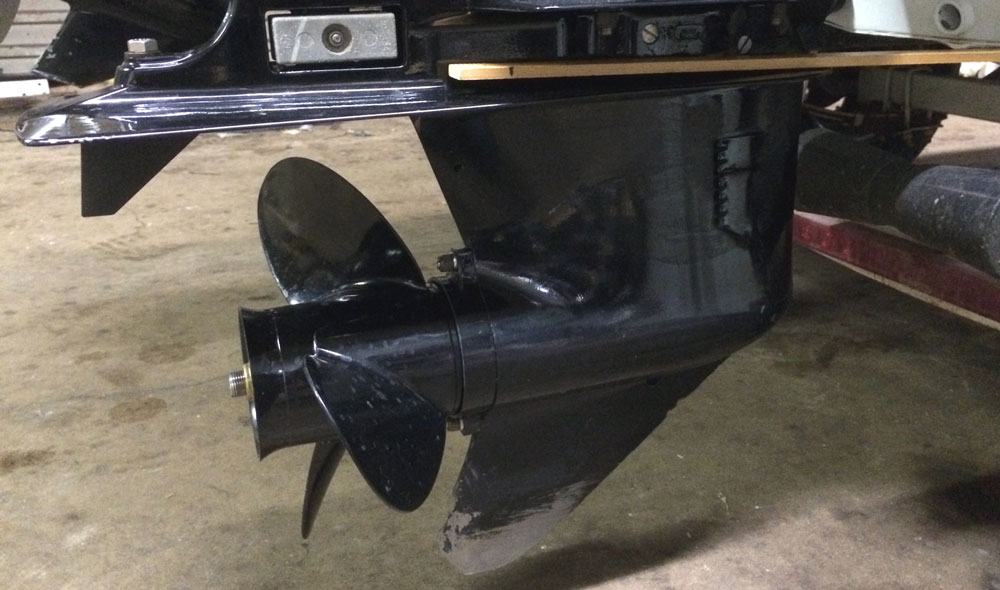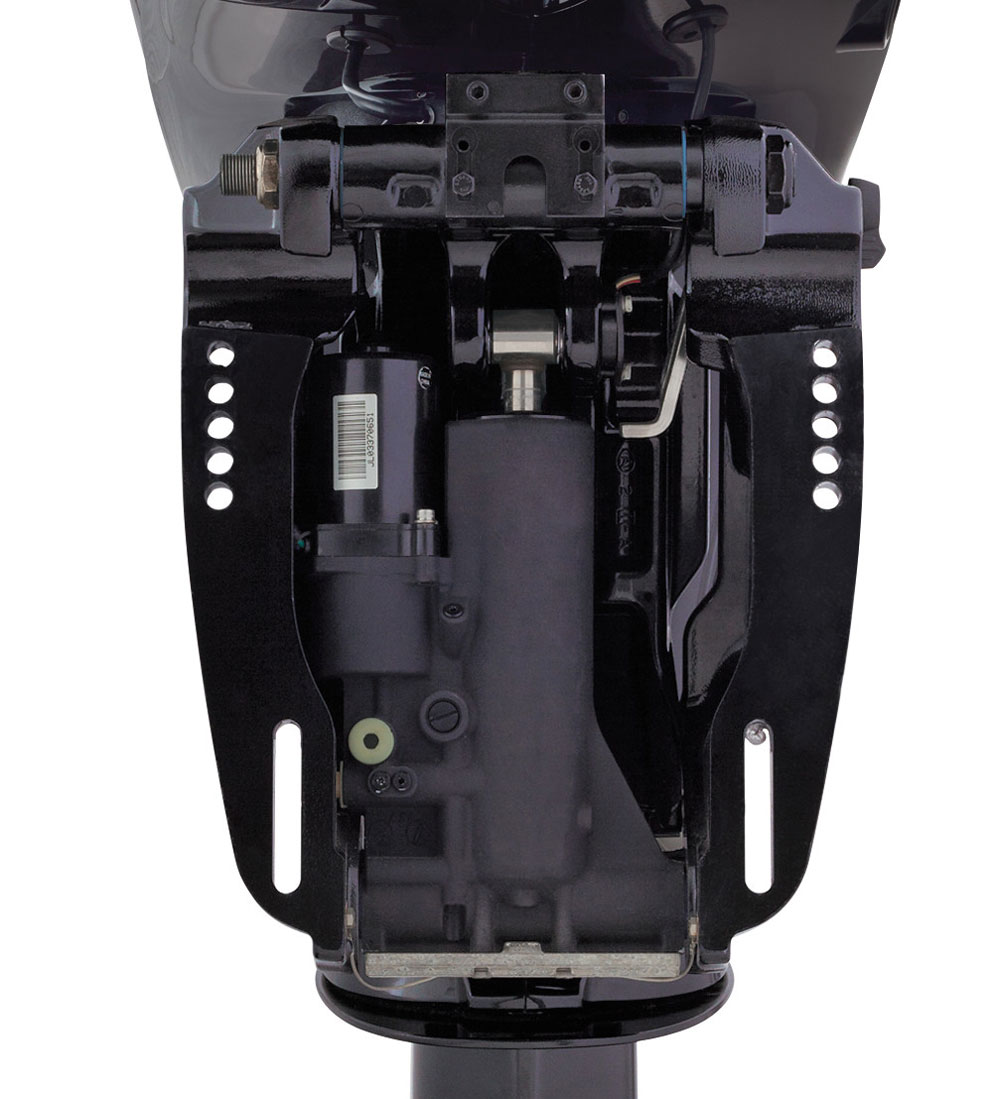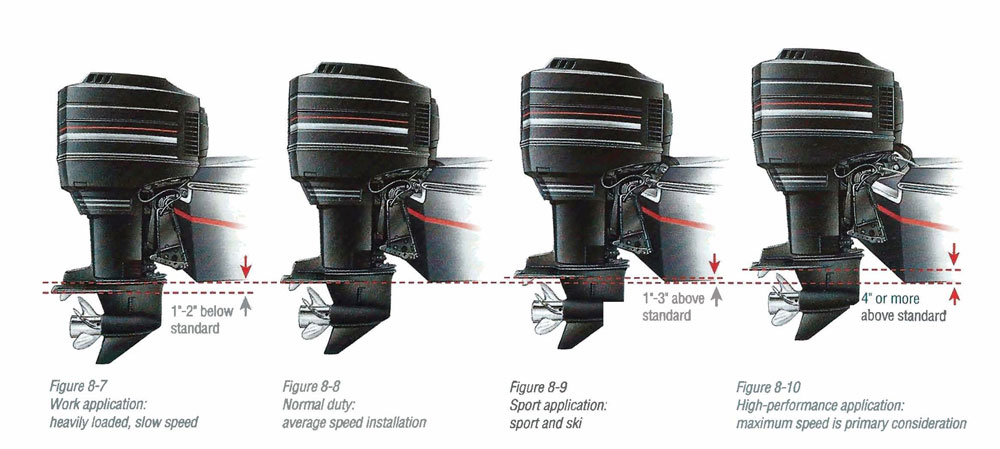Height Adjustments
Posted by Charles Plueddeman on 2nd Feb 2017
Any owner seeking the last bit of speed from an outboard-powered boat should grab a yard stick. Not to measure boat speed, but to gauge the mounting height of the outboard motor on the boat transom. Rest the yard stick or another suitable straight edge along the keel on the bottom of the boat so that it makes a straight line aft to the outboard. With the motor trimmed so that the propshaft is parallel to the keel, the anti-ventilation plate should be just about even with your straight edge, and thus even with the boat bottom at the keel.

A yardstick will help you determine if your outboard engine is at the right height.
“I would say that on a significant majority of the new boats I see the outboard motor is mounted too low,” says David Greenwood, who in his role as product planning manager at Suzuki Marine tests and rigs dozens of boats each year. “At least it’s lower than necessary, because most boat builders are very conservative and to be fair, they have no idea how their boat is going to be propped, loaded, and used after it’s sold.”
LENGTH MATTERS
The length of an outboard is measured from the top of the clamp bracket to the anti-ventilation plate, and motors are offered in four different lengths: S (short, 15 inches), L (long, 20 inches) XL (25 inches) and XXL (30 inches). This is commonly called the motor’s “shaft length” because a longer motor requires a longer drive shaft, but its length is not really the measurement of the drive shaft. These specific motor lengths were agreed upon by engine and boat builders in the 1960s to create standardization in the industry. The motor length corresponds to the transom height of the boat, measured from the keel to gunwale at the transom.
The clamp bracket is designed so that the engine’s mounting height on the transom can be adjusted higher than standard. There are a series of four to six holes at the top of the bracket, and the lower bolts actually fit into slots. The spacing between the upper holes is 0.75 inch. This adjustment is provided to let the boat builder or owner fine-tune the mounting height.

The clamp bracket on the latest Mercury Four-Stoke-model outboards has five mounting bolt holes spaced .75 inches apart.
In some cases boat performance can be improved by mounting the outboard at a higher-than-standard position – with the anti-ventilation plate above the boat bottom. A higher mounting position will reduce lower unit drag and improve top-end speed, although because drag increases exponentially as speed increases, the benefit of reducing drag is more pronounced on faster boats.
“My rule of thumb is based on trim,” says Greenwood. “When I run the boat for the first time, if I can trim the motor to its limit without blowing out the propeller, I’m almost certain I can move the motor up at least one hole on the clamp bracket. I want to have the motor high enough to ventilate the prop when trimmed to the max. Conversely, if the motor is too high I won’t be able to trim much at all.”
Greenwood says that moving the outboard up one mounting hole – or 0.75 inch – will allow the motor to gain RPM at wide-open throttle because drag is reduced.
“If you are 250 RPM low, say about 5700 but you want to get to 6000, raising the motor a hole might get you there, and produce about one additional mile per hour in top speed,” said Greenwood. “Or if you are already at 6000, raising the motor may allow you to move up one increment in prop pitch to stay at 6000 but go faster.”

This illustration depicts four different outboard mounting height options (courtesy Mercury Marine).
There are disadvantages to raising the motor. With the propeller closer to the surface it’s more likely to ventilate and slip on acceleration, making it harder for the boat to get on plane. And the trim tab above the prop may become less effective and make the boat harder to steer at speed.
But if the motor is mounted too low the anti-ventilation plate will drag in the water when the boat is on plane and can cause excessive spray around the motor and transom. Low-speed work boats pushing a heavy load, however, can benefit from having the motor mounted low and the prop deep in the water.
OTHER VARIABLES
There are quite a few variables in play when considering optimal engine height on the transom. A key factor is how far aft the propeller is located from the bottom of the boat. Water flowing from under the boat rises so if the prop is further away from the transom, it may be possible to mount the engine higher. All outboards are different in this regard. For example, a Mercury Verado positions the propeller about six inches further aft than a Mercury OptiMax outboard. A boat rigger’s rule of thumb is that the motor can be raised one inch for each eight to 10 inches of distance between the transom and prop. As the prop moves further aft, it’s also likely to be in cleaner, “harder” water, and be more efficient. This is one reason performance boaters use a set-back device between the boat transom and the motor bracket.
Propeller diameter also can affect the ideal engine mounting height. Switching from a small-diameter prop like a 13.5-inch Mercury Laser II to a 14.5-inch Mercury Enertia effectively lowers the swing of the prop blades by a half-inch.
A TRUE 20
Despite the effort to standardize transom height and motor length, there has been some “creep” by both boat and engine builders over the years. Techs I talked to say that most “L” outboards actually measure about 21 inches, which may be intended to provide a little adjustment latitude – the motor can always be moved up if it’s too long for the transom, but it can’t be moved down. This issue became apparent with the introduction a few seasons ago of the Mercury 150 FourStroke. Mercury engineers designed an all-new mid-section and mounting bracket for that motor and made it exactly 20 inches to the anti-ventilation plate, and have since done the same for its new Mercury 70/90/115 models. Last summer I had a dealer tell me a few customers were having trouble with Merc 150s blowing out the prop on hole-shot and in even moderate turns. The motor was too high but mounted as low as possible. Turns out some boat builders are letting transom height get closer to 21 inches or 26 inches.
There also can be significant imprecision on fiberglass boats. One tech who rigs a lot of motors tells me he measures every transom, and will find up to an inch variance in transom height on different examples of the same boat model. This was exactly the problem encountered by the dealer with the unhappy Merc 150 customers, with the worst cases being on pontoon boats. Because pontoons can create a frothy stream of aerated water at the transom, the prop really needs to be set down in the water.
Greenwood says Suzuki is also moving from a “stretched” length to a “true 20” on its latest DF70A and DF90A motors, and has encountered an occasional issue with a tall transom. The solution is usually a different prop with more blade area, often a four-blade propeller.

